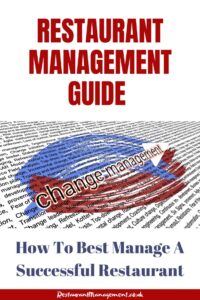Restaurant Management Guide
Managing a restaurant is like leading a finely tuned orchestra: every aspect must align perfectly. When all elements are in harmony, the result is an extraordinary dining experience that keeps customers returning. Running a successful restaurant involves more than just serving delicious meals. It requires consistency, strong leadership, and an understanding of what fosters customer loyalty. Every aspect is crucial for a busy dining space, satisfied customers, and a successful establishment. From the dishes being served to the team working behind the scenes, effectively managing a restaurant demands careful planning and unwavering execution.
The industry is ruthless. One bad experience, one slip in quality, or one overlooked cost—and customers walk. This restaurant management guide breaks down exactly how to get it done right. If you want your restaurant to thrive, not just survive, here’s how to run it like a pro.

Mission Statement and Strategy
If you don’t stand for something, you’ll blend in with everyone else.
Start with your mission. This isn’t just a slogan—it’s your north star, guiding every decision you make. Whether you’re building a farm-to-table bistro or a fast-casual burger spot, your mission defines your food, pricing, staff, service, and space. It’s the foundation of your restaurant’s identity and the essential factor for distinguishing yourself in a crowded marketplace. Your mission statement is your compass, providing direction and purpose to every business decision.
It should be short, clear, and powerful enough to guide every business decision. Are you serving fast-casual vegan food or a high-end steakhouse experience? Make that purpose known. As the Harvard Business Review reported, organisations with a well-defined mission tend to surpass their rivals by an average of 20%.
To craft a successful strategy, focus on five key pillars: location, pricing, menu, target market, and branding. Each component is crucial in shaping your business’s identity and appeal. Consider how your location can attract your ideal customers, how pricing can reflect value while remaining competitive, and how your menu can tantalise taste buds.
Understanding your target market will enable you to customise your products or services, while effective branding will leave a memorable impact. Tailor your offerings, and strong branding will create lasting impressions. Embrace these components to build a strategy that truly stands out!
Know what you stand for. Then act like it every single day.
Strategy is where the vision becomes a plan. It’s your roadmap to success. Know your niche, study your competitors, and understand your customer base. Align pricing, service style, and marketing to that strategy. Consistency is key—you can’t be all things to all people, but with a solid plan, you can be the best at what you do.
Strategy follows. Define your:
- Target audience
- Menu pricing
- Brand personality
- Operational hours
- Location advantages
The sharper your strategy, the more your restaurant stands out.

Managing Production
Food
Food quality is your brand’s heartbeat.
The food is your product. Nothing else matters if it’s not consistent, clean, and crave-worthy. Use standardised recipes, supplier relationships that guarantee quality, and regular kitchen audits. Research published in the International Journal of Hospitality Management indicates that maintaining consistent food quality is among the top three factors contributing to restaurant customer loyalty.
Train your kitchen to achieve consistency. Invest in good suppliers and build long-term relationships. Track waste, conduct line checks, audit portion sizes, and tighten prep processes. The kitchen isn’t a back-end operation—it’s your main product line.
Invest in quality ingredients, track waste, and implement inventory management systems like BlueCart or MarketMan to reduce food costs and boost margins.
BlueCart and MarketMan are designed to improve ordering and inventory management in the restaurant industry, but they cater to different needs. BlueCart focuses primarily on streamlining the ordering process and enhancing supply chain management. They specialise in streamlining distribution processes for the food service industry to improve supply chain management and facilitate better ordering practices.
In contrast, MarketMan offers a more comprehensive cloud-based inventory management platform to help businesses monitor their inventory effectively. It focuses on optimising stock levels and reducing food waste, making it a valuable tool for organisations looking to enhance their operational efficiency.
Both platforms are crucial in enhancing inventory control and operational effectiveness within their respective sectors.
The National Restaurant Association indicates that food waste may account for 4% to 10% of overall food expenses. Store food using FIFO (First In, First Out) and conduct daily inventory checks.
Understand the Customer Experience
You’re not just feeding people. You’re giving them a reason to come back.
You’re not just selling meals—you’re selling moments. Pay attention to every step of the customer journey: reservation, greeting, seating, ordering, serving, billing, and feedback. Watch it unfold in real-time. Listen. Ask. Recognise that every interaction with a customer is a chance to craft an unforgettable experience.
A 2023 Deloitte report found that 60% of guests say their decision to return is more about the experience than the food. Get feedback often—use comment cards, QR codes, and online reviews to spot weak points quickly.
The customer’s experience begins the moment they step in. That includes lighting, music, cleanliness, table spacing, and even how long it takes to be greeted.
Customer experience starts when someone sees your name—online or in person.
Every step counts:
- Reservation Process
- Host greeting
- Wait time
- Cleanliness
- Server attitude
- Food presentation
- Billing
Use secret shoppers, read your reviews, and watch service flow during peak hours. You’ll learn more by listening than guessing.

How to Produce a Great Customer Experience
It’s all about the details.
The best customer experiences feel effortless: music at the right level, smiling staff, water glasses never empty, and hot food delivered. According to a report by the National Restaurant Association, 79% of diners say experience is as essential as food.
Train staff to greet every guest within 30 seconds. Empower servers to fix minor issues on the spot. Keep restrooms spotless—set service time standards (e.g., drinks within 5 minutes, entrees within 15).
Train your team to exceed expectations. Speed matters, but so does empathy. Clean tables, pleasant music, comfortable lighting, and sincere service play a role. Tech tools like guest experience platforms or POS analytics can provide real-time insights.
Leverage tech like OpenTable for reservations and Toast for POS and feedback collection. Consistency builds loyalty. Every touchpoint should reflect your brand promise.
Here’s how to nail it:
- Train for service recovery: fix problems fast and with empathy.
- Build ambience: lighting, seating, decor, and music affect mood.
- Use tech: table tracking, mobile ordering, and CRM tools to improve speed and personalisation.
Managing Your Employees
Hire the Right Staff
Skill matters. Attitude matters more.
When building a strong team, remember that skill is important, but attitude is everything. Don’t just fill shifts—create a culture. Look for more than just experience. Hire for energy, reliability, communication skills, work ethic, and alignment with your culture.
These are the people who will bring your mission to life. Skills can be trained, but values can’t. Use structured interviews and practical tests. For example, ask cooks to prepare a dish or servers to roleplay a greeting. Use roleplay scenarios during interviews to test problem-solving. Seek people who care.
Use structured interviews and practical tests. For example, ask cooks to prepare a dish or servers to roleplay a greeting. Use roleplay scenarios during interviews to test problem-solving. Seek people who care.
Use working interviews to test fit. According to the Society for Human Resource Management, poor hiring decisions cost up to 30% of the employee’s first-year salary. Smart hiring now saves you hours of headaches later.

Train Employees Well
No one is too busy to train. You’ll pay for it in mistakes and turnover if you skip it.
Training is not optional. Create an onboarding program that includes food safety, service standards, and your restaurant’s mission. Use shadowing, checklists, and quizzes to build confidence. Cover customer service, menu knowledge, and upselling techniques.
According to Cornell University’s School of Hotel Administration, proper onboarding reduces turnover by up to 50%.
Build a structured training system with the following:
- Food safety certifications
- Customer service roleplays
- POS and kitchen system tutorials
- Clear brand standards
Restaurants that train properly cut turnover by 25% (Cornell University Center for Hospitality Research).
Restaurant Menu Planning: 12 Tips On How to Design the Perfect Restaurant Menu
Clearly Define Employee Roles
If everyone does everything, no one does anything right.
Ambiguity breeds confusion and kills productivity. Use clear job descriptions and ensure every employee knows who does what and when.
Make responsibilities clear. Post job descriptions and hold regular briefings. Use a shift log so all team members are updated on what’s happening and what’s expected.
Outline duties in writing for each position—line cook, server, host, dishwasher. Post these roles in staff areas and review them during training.
This clarity increases accountability and performance.

Release Work Schedules promptly
Last-minute scheduling kills morale.
Use scheduling software to set shifts in advance. Consider staff availability, performance, and labour costs and post the staff schedules at least two weeks in advance. Use tools like 7shifts or HotSchedules. Respect your staff’s time; they’ll repay you in loyalty and productivity.
This one’s simple but powerful. Predictability improves morale. Scheduling software reduces conflicts and tracks labour costs. Happy employees make happy customers.
Best Restaurant Management Software: Top 5 Solutions To Skyrocket Profits
Finances
Understand Your Cash Flow
Cash is king. Track daily sales, labour costs, and food expenses. Use accounting software like QuickBooks or Xero to reconcile accounts weekly.
Restaurants typically operate on tight margins (4-6% average), so real-time awareness is non-negotiable.
Cash flow is king. Track it daily. Know what’s coming in and what’s going out. Don’t rely on gut feelings. Use accounting software that connects with your point of sale system.
Profit doesn’t mean cash in hand.
Use historical data to project your financials—factor in seasonality, events, and marketing campaigns. A report from SCORE (Service Corps of Retired Executives) shows that businesses with forecasts are twice as likely to grow.
Predict slow months, busy seasons, and significant expenses. Create a 12-month rolling forecast. Adjust staffing and ordering accordingly.
A study by the U.S. Bank revealed that 82% of small businesses fail due to inadequate cash flow management. Avoid surprises; plan.
Cash flow is the difference between staying open and shutting down. Track your daily, weekly, and monthly inflows and outflows. Include:
- Sales vs. costs
- Payroll
- Vendor payments
- Taxes
- Rent/utilities
Use restaurant-specific accounting software that links with your POS.
Create a Cash Flow Forecast
Don’t just track money. Predict it.
Use historical data to forecast busy seasons, slow months, and marketing campaign results. Build in margins for emergencies. SCORE reports that businesses with solid cash flow forecasts are 2x more likely to scale profitably.

Marketing
What Do You Want Your Marketing to Achieve?
Don’t post to post.
Define the goal: Brand awareness? More lunch traffic? Bigger online orders? Each campaign should have a specific, measurable outcome.
Decide what you want—more reservations, new customer leads, a larger ticket size, or return visits. Set one core goal per campaign.
Who is Your Marketing Aimed At?
Know your audience: Segment your audience. Are families, young professionals, or vegans? Create customer personas. Each group needs a different message and channel.
Are you attracting:
- Families looking for casual meals?
- Young professionals looking for Instagram-worthy dishes?
- Locals who want loyalty perks?
Build personas and market directly to their needs.
What is Your Message?
Your message should reflect your mission. Be clear, specific, and relatable. Avoid generic ads. Show your food. Tell your story. This is your unique value. Maybe it’s “farm-to-table freshness” or “five-star meals in under 10 minutes.” Be specific and repeat it often
Example: A farm-to-table place might highlight local sourcing and seasonal dishes. A burger joint could focus on juicy close-ups and combo deals. Be clear, direct, and unique.
What is Your Offer?
Give people a reason to show and act: discounts, events, special menus, loyalty programs. Make it timely and relevant. Promotions work. Try “Buy One Get One Free Tuesdays” or “10% off your first online order.” Track redemption rates to measure effectiveness.
Whether it’s “Kids Eat Free on Tuesdays” or “Happy Hour from 4–6 PM,” tailor your offers to your best customers. Time-bound promos work best.
6 Effective Restaurant Management Skills To Skyrocket Unlimited Success
How Can You Measure Your Marketing ROI?
Use Google Analytics, Meta Ads Manager, and POS-integrated marketing tools—to set KPIs: conversion rates, email sign-ups, and return visits. Track what works and what doesn’t. Adjust quickly. Aim for data-driven decisions.
Track everything.
Use:
- Google Analytics for web traffic
- Social media insights
- POS tags for promo codes
- Email open and click rates.
- QR code scans
Compare campaign costs to revenue generated. Kill what doesn’t work. Double down on what it does.
Procedures
Why Create Standard Operating Procedures?
SOPs make sure everyone’s playing from the same sheet.
Consistency creates trust. SOPs reduce errors, save time, and ensure every guest gets the same high-quality experience. They reduce risk, maintain consistency, and speed up training. The Journal of Organisational Behavior found SOPs directly improve employee performance and accountability.

How to Create Standard Operating Procedures
Break down each task: Opening duties, closing checklist, service flow, order taking, and food prep. Write them down. Add visuals where helpful. Store digitally for access anywhere.
Review and update quarterly. Involve team members in creating them—they’ll feel ownership and follow them better.
Write SOPs for everything:
- Opening/closing routines
- Cleaning schedules
- Food prep and handling
- Inventory tracking
- Emergency response
- Reservation handling
Transform them into visual formats like flowcharts, checklists, and videos. Educate new employees on these materials. Assess employees’ understanding every three months. SOPs should be considered dynamic documents, not fixed PDFs.
Related articles
Levels Of Management In A Restaurant
Best Restaurant Management Software
Restaurant Management Tips Success
Effective Restaurant Management
Fast Food Restaurant Management Systems
Conclusion
Restaurant management is about precision, not guesswork. Planning, people, performance, and profit are all working in sync. It blends vision with execution. It’s about setting high standards and meeting them every day.
Start with a mission that means something. Deliver food and service people rave about. Build a team that believes in what you do. Know your numbers cold. Market with intention. Document everything that matters. Done right, it’s not just a business—it’s a brand people trust, remember, and return to If you want your restaurant to thrive, manage it like a pro. No shortcuts. Just intelligent, solid systems that work. Restaurants don’t fail because of bad luck. They fail because of bad systems. Put the right systems in place; your restaurant won’t just survive—it’ll thrive.
The Ultimate Guide to Fast Food Restaurant Management Systems


